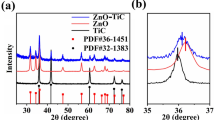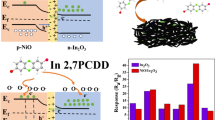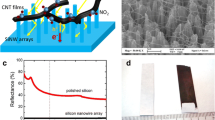Abstract
As a strong oxidizing pollutant, NO2 can cause fire or even explosion. People living in atmosphere containing NO2 for a long time will significantly affects human health. In this work, we developed a Schottky heterojunction sensor modified by g-C3N4 quantum dots (g-C3N4QDs) and rGO deposited on TiO2 nanotubes (TNTs) arrays. This sensor showed high response and extremely fast response/recovery time as well as excellent detection of ppb level of NO2 at room temperature. TNTs were obtained using a one-step anodic oxidation process. TNTs were modified with g-C3N4QDs and rGO using quasi-CVD method and cyclic voltammetry during in situ electrodeposition, respectively. TNTs/g-C3N4QDs/rGO Schottky heterojunction sensor exhibited high sensitivity to 10 ppm of NO2 (response equal to 15982) at room temperature. Below 15 ppb, sensing response also can reach 127. Sensor response was very fast and increased to 15982 in just 2 s when exposed to 10 ppm of NO2 after which it recovers 90% within 1.16 s. This work clarified the influence of abundant oxygen vacancies (VO·) in TNTs and photogenerated electrons on TNTs/g-C3N4QDs/rGO nanostructures as well as their sensing performances. Our experimental details demonstrated that Schottky barrier was established between TNTs and rGO, which was very beneficial for ppb-level NO2 detection at room temperature.













Similar content being viewed by others
Explore related subjects
Discover the latest articles and news from researchers in related subjects, suggested using machine learning.References
Shiliang J, Haibo W, Tong W, Donghang Y (2013) A high-performance room-temperature NO2 sensor based on an ultrathin heterojunction film. Adv Mater 25:1755–1760
Antonio T, Marco R, Alexandra T (2010) Semiconductor gas sensors: dry synthesis and application. Angew Chem 49:7632–7659
Kong J, Franklin NR, Zhou C, Chapline MG, Peng S, Cho K, Dai H (2000) Nanotube molecular wires as chemical sensors. Science 287:622–625
Vanalakar SA, Patil VL, Harale NS, Vhanalakar SA, Gang MG, Jin YK, Patil PS, Jin HK (2015) Controlled growth of ZnO nanorod arrays via wet chemical route for NO2 gas sensor applications. Sens Actuators B Chem 221:1195–1201
Andringa AM, Meijboom JR, Smits ECP, Mathijssen SGJ, Blom PWM, Leeuw DMD (2011) Gate-bias controlled charge trapping as a mechanism for NO2 detection with field-effect transistors. Adv Funct Mater 21:100–107
Shendage SS, Patil VL, Vanalakar SA, Patil SP, Harale NS, Bhosale JL, Kim JH, Patil PS (2017) Sensitive and selective NO2 gas sensor based on WO3 nanoplates. Sens Actuators B Chem 240:426–433
Lauhon LJ, Gudiksen MS, Wang D, Lieber CM (2002) Epitaxial core/shell and core multishell nanowire heterostructures. Nature 420:57
Wang Y, Liu MX, Ling T, Tang CC, Zhi CY, Du XW (2014) Gas-phase anion exchange towards ZnO/ZnSe heterostructures with intensive visible light emission. J Mater Chem C 2:2793–2798
Gautam UK, Xiaosheng F, Yoshio B, Jinhua Z, Dmitri G (2008) Synthesis, structure, and multiply enhanced field-emission properties of branched ZnS nanotube-in nanowire core-shell heterostructures. ACS Nano 2:1015–1021
Fang Q, Yat L, Silvija G, Hong-Gyu P, Yajie D, Yong D, Zhong Lin W, Lieber CM (2008) Multi-quantum-well nanowire heterostructures for wavelength-controlled lasers. Nat Mater 7:701–706
Ya Y, Pradel KC, Qingshen J, Jyh Ming W, Fang Z, Yusheng Z, Yue Z, Zhong Lin W (2012) Thermoelectric nanogenerators based on single Sb-doped ZnO micro/nanobelts. ACS Nano 6:6984–6989
Kempa TJ (2007) Coaxial silicon nanowires as solar cells and nanoelectronic power sources. Nature 449:885
Gu F, Zeng H, Zhu Y, Yang Q, Ang LK, Zhuang S (2014) Single-crystal Pd and its alloy nanowires for plasmon propagation and highly sensitive hydrogen detection. Adv Opt Mater 2:189–196
Zhang J, Liu X, Neri G, Pinna N (2016) Nanostructured materials for room-temperature gas sensors. Adv Mater 28:795–831
Hu J, Zou C, Su Y, Li M, Han Y, Kong ES-W, Yang Z, Zhang Y (2018) An ultrasensitive NO2 gas sensor based on a hierarchical Cu2O/CuO mesocrystal nanoflower. J Mater Chem A 6:17120–17131
Yang Z, Guo L, Zu B, Guo Y, Xu T, Dou X (2014) CdS/ZnO core/shell nanowire-built films for enhanced photodetecting and optoelectronic gas-sensing applications. Adv Opt Mater 2:738–745
Schierbaum K, Kirner U, Geiger J, Göpel W (1991) Schottky-barrier and conductivity gas sensors based upon Pd/SnO2 and Pt/TiO2. Sens Actuators B Chem 4:87–94
Guo L, Yang Z, Dou X (2017) Artificial olfactory system for trace identification of explosive vapors realized by optoelectronic schottky sensing. Adv Mater 29:1604528
Galstyan V, Ponzoni A, Kholmanov I, Natile MM, Comini E, Nematov S, Sberveglieri G (2018) Reduced graphene oxide–tio2 nanotube composite: comprehensive study for gas sensing applications. ACS Appl Nano Mater 1:7098–7105
Irokawa Y (2011) Hydrogen sensors using nitride-based semiconductor diodes: the role of metal/semiconductor interfaces. Sensors 11:674–695
Hasegawa H, Akazawa M (2008) Mechanism and control of current transport in GaN and AlGaN Schottky barriers for chemical sensor applications. Appl Surf Sci 254:3653–3666
Miyoshi M, Kuraoka Y, Asai K, Shibata T, Tanaka M, Egawa T (2007) Electrical characterization of Pt/AlGaN/GaN Schottky diodes grown using AlN template and their application to hydrogen gas sensors. J Vac Sci Technol B 25:1231–1235
Te-Yu W, Ping-Hung Y, Shih-Yuan L, Zhong Lin W (2009) Gigantic enhancement in sensitivity using Schottky contacted nanowire nanosensor. J Am Chem Soc 131:17690–17695
Yeh PH, Li Z, Wang ZL (2009) Schottky-gated probe-free ZnO nanowire biosensor. Adv Mater 21:4975–4978
Singh A, Uddin MA, Sudarshan T, Koley G (2014) Tunable reverse-biased graphene/silicon heterojunction schottky diode sensor. Small 10:1555–1565
Schedin F, Geim A, Morozov S, Hill E, Blake P, Katsnelson M, Novoselov K (2007) Detection of individual gas molecules adsorbed on graphene. Nat Mater 6:652
Li X, Wang X, Zhang L, Lee S, Dai H (2008) Chemically derived, ultrasmooth graphene nanoribbon semiconductors. Science 319:1229–1232
Wang X, Zhi L, Müllen K (2008) Transparent, conductive graphene electrodes for dye-sensitized solar cells. Nano Lett 8:323–327
Blake P, Brimicombe PD, Nair RR, Booth TJ, Jiang D, Schedin F, Ponomarenko LA, Morozov SV, Gleeson HF, Hill EW (2008) Graphene-based liquid crystal device. Nano Lett 8:1704–1708
Cao Y, Zhu J, Xu J, He J, Sun JL, Wang Y, Zhao Z (2014) Ultra-broadband photodetector for the visible to terahertz range by self-assembling reduced graphene oxide-silicon nanowire array heterojunctions. Small 10:2345–2351
Fattah A, Khatami S, Mayorga-Martinez CC, Medina-Sánchez M, Baptista-Pires L, Merkoçi A (2014) Graphene/silicon heterojunction schottky diode for vapors sensing using impedance spectroscopy. Small 10:4193–4199
Yang H, Heo J, Park S, Song HJ, Seo DH, Byun K-E, Kim P, Yoo I, Chung H-J, Kim K (2012) Graphene barristor, a triode device with a gate-controlled Schottky barrier. Science 336:1140–1143
Galstyan V, Comini E, Baratto C, Ponzoni A, Ferroni M, Poli N, Bontempi E, Brisotto M, Faglia G, Sberveglieri G (2015) Large surface area biphase titania for chemical sensing. Sens Actuators B Chem 209:1091–1096
Zhang S, Hang NT, Zhang Z, Yue H, Yang W (2017) Preparation of g-C3N4/graphene composite for detecting NO2 at room temperature. Nanomaterials 7:12
Li X, Zhu H, Wang K, Cao A, Wei J, Li C, Jia Y, Li Z, Li X, Wu D (2010) Graphene-on-silicon Schottky junction solar cells. Adv Mater 22:2743–2748
Wu K, Dong X, Zhu J, Wu P, Liu C, Wang Y, Wu J, Hou J, Liu Z, Guo X (2018) Designing biomimetic porous celery: Tio2/ZnO nanocomposite for enhanced CO2 photoreduction. J Mater Sci 53:11595–11606. https://doi.org/10.1007/s10853-018-2397-y
An T, Tang J, Zhang Y, Quan Y, Gong X, Al-Enizi AM, Elzatahry AA, Zhang L, Zheng G (2016) Photoelectrochemical conversion from graphitic C3N4 quantum dot decorated semiconductor nanowires. ACS Appl Mater Interfaces 8:12772–12779
Zhu S, Meng Q, Wang L, Zhang J, Song Y, Jin H, Zhang K, Sun H, Wang H, Yang B (2013) Highly photoluminescent carbon dots for multicolor patterning, sensors, and bioimaging. Angew Chem 125:4045–4049
Cao S, Low J, Yu J, Jaroniec M (2015) Polymeric photocatalysts based on graphitic carbon nitride. Adv Mater 27:2150–2176
Hummers WS Jr, Offeman RE (1958) Preparation of graphitic oxide. J Am Chem Soc 80:1339
Lei Y, Zhang L, Meng G, Li G, Zhang X, Liang C, Chen W, Wang S (2001) Preparation and photoluminescence of highly ordered TiO2 nanowire arrays. Appl Phys Lett 78:1125–1127
Wang Y, Hu G, Duan X, Sun H, Xue Q (2002) Microstructure and formation mechanism of titanium dioxide nanotubes. Chem Phys Lett 365:427–431
Chen L, Tang Y, Wang K, Liu C, Luo S (2011) Direct electrodeposition of reduced graphene oxide on glassy carbon electrode and its electrochemical application. Electrochem Commun 13:133–137
Su J, Lin Z, Geng P, Chen G (2016) Self-assembly graphitic carbon nitride quantum dots anchored on TiO2 nanotube arrays: an efficient heterojunction for pollutants degradation under solar light. J Hazard Mater 316:159–168
Cao Y, Zhu J, Xu J, He J, Sun JL, Wang Y, Zhao Z (2014) Ultra-broadband photodetector for the visible to terahertz range by self-assembling reduced graphene oxide-silicon nanowire array heterojunctions. Small 10:2345–2351
Zhang N, Zhang Y, Pan X, Fu X, Liu S, Xu YJ (2012) Assembly of CdS nanoparticles on the two-dimensional graphene scaffold as visible-light-driven photocatalyst for selective organic transformation under ambient conditions. J Phys Chem C 116:23501–23511
Fang-Xing X, Jianwei M, Bin L (2014) Layer-by-layer self-assembly of CdS quantum dots/graphene nanosheets hybrid films for photoelectrochemical and photocatalytic applications. J Am Chem Soc 136:1559–1569
Lin X, Xu D, Zheng J, Song M, Che G, Wang Y, Yang Y, Liu C, Zhao L, Chang L (2016) Graphitic carbon nitride quantum dots loaded on leaf-like InVO4/BiVO4 nanoheterostructures with enhanced visible-light photocatalytic activity. J Alloy Compd 688:891–898
Khomenko VM, Langer K, Rager H, Fett A (1998) Electronic absorption by Ti3+ ions and electron delocalization in synthetic blue rutile. Phys Chem Miner 25:338–346
Qu J, Ge Y, Zu B, Li Y, Dou X (2016) Transition-metal-doped p-type ZnO nanoparticle-based sensory array for instant discrimination of explosive vapors. Small 12:1369–1377
Wang J, Zhang P, Li X, Zhu J, Li H (2013) Synchronical pollutant degradation and H2 production on a Ti3+ -doped TiO2 visible photocatalyst with dominant (001) facets. Appl Catal B 134–135:198–204
Erdem B, Hunsicker RA, Simmons GW, Sudol ED, And VLD, Elaasser MS (2001) XPS and FTIR surface characterization of TiO2 particles used in polymer encapsulation. Langmuir 17:2664–2669
Yun Z, Lihua L, Bo W, Xinchen W (2016) Graphitic carbon nitride polymers toward sustainable photoredox catalysis. Angew Chem 46:12868
Shubin Y, Yongji G, Jinshui Z, Liang Z, Lulu M, Zheyu F, Robert V, Xinchen W, Ajayan PM (2013) Exfoliated graphitic carbon nitride nanosheets as efficient catalysts for hydrogen evolution under visible light. Adv Mater 44:2452
Liang Q, Li Z, Yu X, Huang ZH, Kang F, Yang QH (2015) Macroscopic 3D porous graphitic carbon nitride monolith for enhanced photocatalytic hydrogen evolution. Adv Mater 27:4634–4639
Jiang Z, Zhu C, Wan W, Qian K, Xie J (2015) Constructing graphite-like carbon nitride modified hierarchical yolk–shell TiO2 spheres for water pollution treatment and hydrogen production. J Mater Chem A 4:1806–1818
Yao Z, Yan J, Jun C, Jian L, Ji L, Aijun D, Weimin Z, Zhonghua Z, Smith SC, Mietek J (2011) Nanoporous graphitic-C3N4@carbon metal-free electrocatalysts for highly efficient oxygen reduction. J Am Chem Soc 133:20116–20119
Yang X, Salzmann C, Shi H, Wang H, Green ML, Xiao T (2008) The role of photoinduced defects in TiO2 and its effects on hydrogen evolution from aqueous methanol solution. J Phys Chem A 112:10784
Li F, Gao X, Wang R, Zhang T, Lu G (2017) Study on TiO2-SnO2 core-shell heterostructure nanofibers with different work function and its application in gas sensor. Sens Actuators B Chem 248:812–819
Yang S, Wang Z, Hu Y, Luo X, Lei J, Zhou D, Fei L, Wang Y, Gu H (2015) Highly responsive room-temperature hydrogen sensing of α-MoO3 nanoribbon membranes. ACS Appl Mater Interfaces 7:9247–9253
Hosseini Z, Mortezaali A (2015) Room temperature H2S gas sensor based on rather aligned ZnO nanorods with flower-like structures. Sens Actuators B Chem 207:865–871
Shao L, Wu Z, Duan H, Shaymurat T (2018) Discriminative and rapid detection of ozone realized by sensor array of Zn2+ doping tailored MoS2 ultrathin nanosheets. Sens Actuators B Chem 258:937–946
Li Y, Song Z, Li Y, Chen S, Li S, Li Y, Wang H, Wang Z (2019) Hierarchical hollow MoS2 microspheres as materials for conductometric NO2 gas sensors. Sens Actuators B Chem 282:259–267
Kumar R, Goel N, Kumar M (2017) UV-activated MoS2 based fast and reversible NO2 sensor at room temperature. ACS Sens 2:1744–1752
Wang C, Sun R, Li X, Sun Y, Sun P, Liu F, Lu G (2014) Hierarchical flower-like WO3 nanostructures and their gas sensing properties. Sens Actuators B Chem 204:224–230
Prajapati CS, Bhat N (2018) ppb level detection of NO2 using a WO3 thin film-based sensor: material optimization, device fabrication and packaging. RSC Adv 8:6590–6599
Deng S, Tjoa V, Fan HM, Tan HR, Sayle DC, Olivo M, Mhaisalkar S, Wei J, Sow CH (2012) Reduced graphene oxide conjugated Cu2O nanowire mesocrystals for high-performance NO2 gas sensor. J Am Chem Soc 134:4905–4917
Kim Y-S, Hwang I-S, Kim S-J, Lee C-Y, Lee J-H (2008) CuO nanowire gas sensors for air quality control in automotive cabin. Sens Actuators B Chem 135:298–303
Liu S, Yu B, Zhang H, Fei T, Zhang T (2014) Enhancing NO2 gas sensing performances at room temperature based on reduced graphene oxide-ZnO nanoparticles hybrids. Sens Actuators B Chem 202:272–278
Dong YL, Zhang XF, Cheng XL, Xu YM, Gao S, Zhao H, Huo LH (2014) Highly selective NO2 sensor at room temperature based on nanocomposites of hierarchical nanosphere-like a-Fe2O3 and reduced graphene oxide. Rsc Adv 4:57493–57500
Li L, He S, Liu M, Zhang C, Chen W (2015) Three-dimensional mesoporous graphene aerogel-supported SnO2 nanocrystals for high-performance NO2 gas sensing at low temperature. Anal Chem 87:1638–1645
Kim YH, Kim SJ, Kim Y-J, Shim Y-S, Kim SY, Hong BH, Jang HW (2015) Self-activated transparent all-graphene gas sensor with endurance to humidity and mechanical bending. ACS Nano 9:10453–10460
Acknowledgements
This work was supported financially by funding from the National Natural Science Foundation of China (21866028, 61704114, 51662036,), Graduate Student Scientific Research Innovation Projects in Xinjiang Autonomous Region (XJGRI2017046), Achievements Transformation and Technique Extension Projection in Shihezi University (CGZH201603) and Open Foundation of Engineering Research Center of Materials-Oriented Chemical Engineering of Xinjiang Bintuan (2016BTRC005).
Author information
Authors and Affiliations
Corresponding authors
Additional information
Publisher's Note
Springer Nature remains neutral with regard to jurisdictional claims in published maps and institutional affiliations.
Rights and permissions
About this article
Cite this article
Dong, X., Wu, K., Zhu, W. et al. TiO2 nanotubes/g-C3N4 quantum dots/rGO Schottky heterojunction nanocomposites as sensors for ppb-level detection of NO2. J Mater Sci 54, 7834–7849 (2019). https://doi.org/10.1007/s10853-019-03468-x
Received:
Accepted:
Published:
Issue Date:
DOI: https://doi.org/10.1007/s10853-019-03468-x




